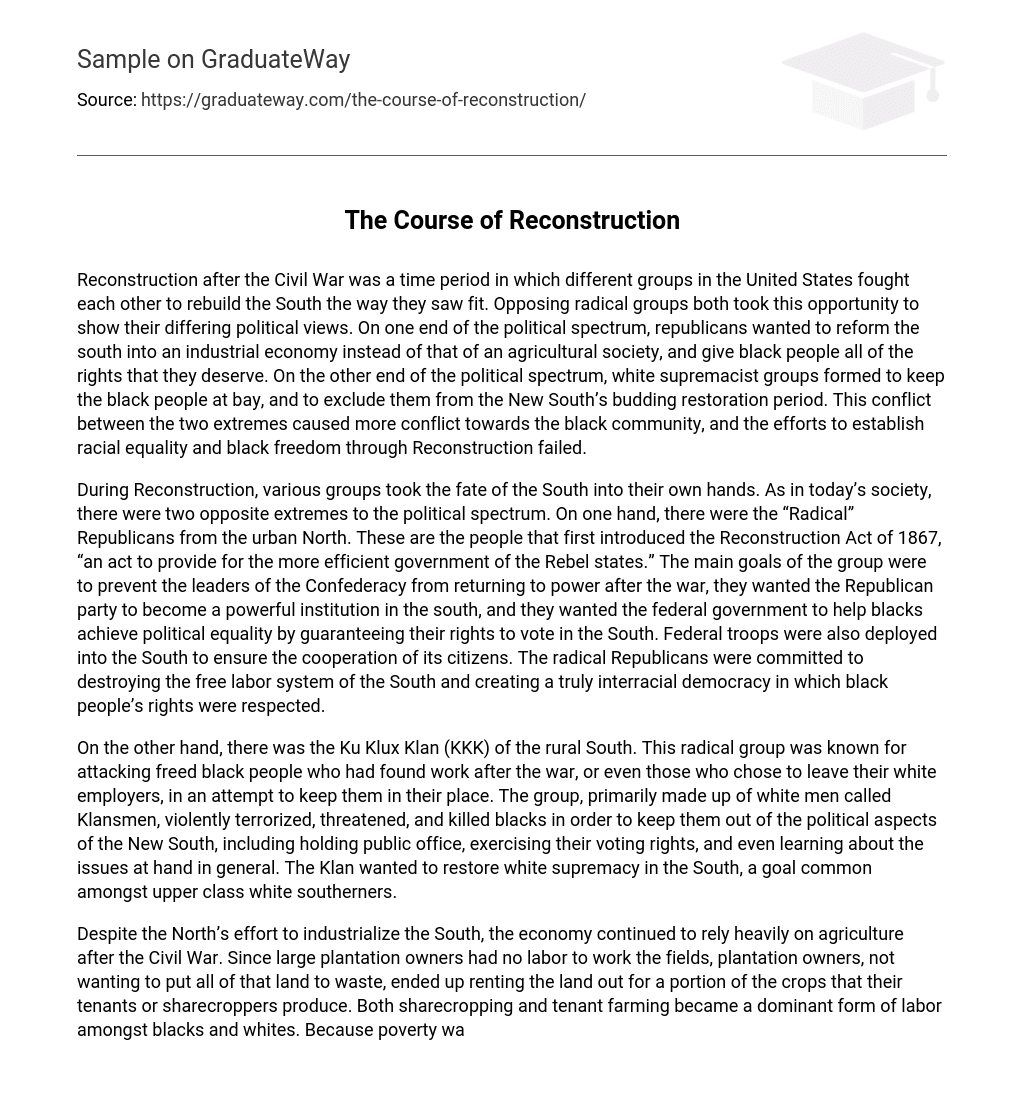Reconstruction after the Civil War was a time period in which different groups in the United States fought each other to rebuild the South the way they saw fit. Opposing radical groups both took this opportunity to show their differing political views. On one end of the political spectrum, republicans wanted to reform the south into an industrial economy instead of that of an agricultural society, and give black people all of the rights that they deserve. On the other end of the political spectrum, white supremacist groups formed to keep the black people at bay, and to exclude them from the New South’s budding restoration period. This conflict between the two extremes caused more conflict towards the black community, and the efforts to establish racial equality and black freedom through Reconstruction failed.
During Reconstruction, various groups took the fate of the South into their own hands. As in today’s society, there were two opposite extremes to the political spectrum. On one hand, there were the “Radical” Republicans from the urban North. These are the people that first introduced the Reconstruction Act of 1867, “an act to provide for the more efficient government of the Rebel states.” The main goals of the group were to prevent the leaders of the Confederacy from returning to power after the war, they wanted the Republican party to become a powerful institution in the south, and they wanted the federal government to help blacks achieve political equality by guaranteeing their rights to vote in the South. Federal troops were also deployed into the South to ensure the cooperation of its citizens. The radical Republicans were committed to destroying the free labor system of the South and creating a truly interracial democracy in which black people’s rights were respected.
On the other hand, there was the Ku Klux Klan (KKK) of the rural South. This radical group was known for attacking freed black people who had found work after the war, or even those who chose to leave their white employers, in an attempt to keep them in their place. The group, primarily made up of white men called Klansmen, violently terrorized, threatened, and killed blacks in order to keep them out of the political aspects of the New South, including holding public office, exercising their voting rights, and even learning about the issues at hand in general. The Klan wanted to restore white supremacy in the South, a goal common amongst upper class white southerners.
Despite the North’s effort to industrialize the South, the economy continued to rely heavily on agriculture after the Civil War. Since large plantation owners had no labor to work the fields, plantation owners, not wanting to put all of that land to waste, ended up renting the land out for a portion of the crops that their tenants or sharecroppers produce. Both sharecropping and tenant farming became a dominant form of labor amongst blacks and whites. Because poverty was more prevalent amongst blacks, however, sharecropping became the dominant form of labor. A sharecropper is a person who enters an agreement with a landowner to farm the land, and in turn pays a portion of the produce as rent. This is similar to that of the lords and serfs of the medieval era. Sharecropping took hold and remained a big part of the economy until the 1950s because it created an economically efficient form of labor by providing an incentive for the workers to produce a bigger harvest.
Reconstruction ended as a direct result of the opposing Southerners’ views. Because the people who wanted to change the South were not from there and held no respect, they were met with confrontation by the majority. President Andrew Johnson, a conservative white elitist, had the Civil Rights Act of 1875 declared unconstitutional by a conservative Supreme Court. Civil rights, being an issue that republicans found more pressing than restoring the South, opted to trade the next presidential election for the premature removal of federal troops from the South. This compromise officially ended Reconstruction, and within a few short years, the powerful white elite had returned to power in southern legislatures and had reinstated its racist policies in the South.
Reconstruction failed to establish racial equality and black freedom. By the end of Reconstruction, many Southern states had regained seats in the legislature, and by 1877, Democrats were the majority in every Southern state. Southern officials were backed by the Ku Klux Klan, and even endorsed the terrorist group. The North’s efforts to penetrate the South’s economy and legislature failed because of the strong rooted racist culture embedded in the South, and the end of reconstruction set back the hopes for equality for blacks in the south for years.





